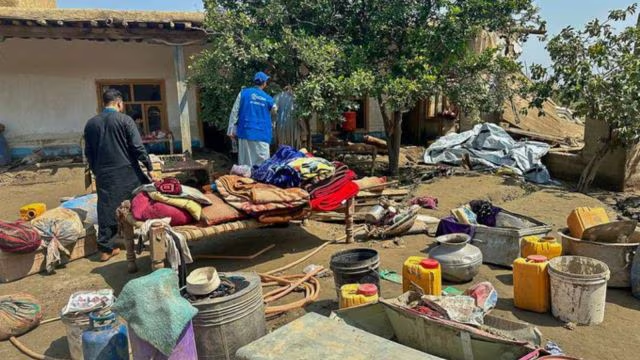Ground Shakes, Hearts Break: Over 800 Dead in Afghanistan Earthquake, PM Modi Promises Aid

Image via The Indian Express
Kabul, September 1, 2025 – Afghanistan has been struck by one of the deadliest earthquakes in recent years. The powerful quake hit late on Sunday night, shaking eastern provinces and leaving behind a trail of destruction. According to early reports, at least 800 people have died and more than 2,500 are injured. Officials fear that the numbers may rise further as rescue workers reach remote mountain villages.
The earthquake measured magnitude 6.0 on the Richter scale and struck close to Jalalabad city, affecting Kunar and Nangarhar provinces the most. Its shallow depth of just 8 kilometers made the shaking more intense. Whole neighborhoods collapsed in seconds. Mud-brick homes, common in Afghan villages, could not withstand the tremors and crumbled instantly.
Fear and Panic in the Dark of Night
The disaster struck around 11:47 pm local time, when most families were asleep. In minutes, houses turned to rubble. Survivors said they woke to screams, falling walls, and dust filling the air. Families rushed out in the dark, carrying children in their arms. Many were trapped under collapsed roofs.
Villages such as Nur Gul, Soki, Watpur, Manogi, and Chapadare in Kunar province were flattened. Emergency workers described entire stretches of land where nothing but broken walls and debris remain. Eyewitnesses said it looked like a “war zone” with no buildings left standing.
Human Toll Rising by the Hour
The Afghan authorities reported at least 800 confirmed deaths. Health workers say that more than 2,500 injured people have already been brought to local hospitals. Many more remain buried under the rubble.
Ambulances, stretchers, and even donkey carts are being used to transport victims. Hospitals are running out of beds. Doctors say they need more medicines, oxygen cylinders, and surgical equipment. Women and children are among the worst affected. Aid groups explained that in some conservative regions, cultural rules are making it harder for women to access quick treatment because of the shortage of female doctors.
Rescue and Relief Operations
Rescue efforts started immediately, but conditions are very tough. The quake triggered landslides in mountainous areas. Many roads are blocked by rocks and mud. Phone lines and internet services are also down in several villages, making it hard to coordinate.
The Afghan military has deployed helicopters. More than 40 emergency flights have been made to airlift injured people to Jalalabad and Kabul. Volunteers are digging through rubble with their bare hands, searching for survivors.
The United Nations has stepped in with emergency aid. Relief trucks carrying tents, blankets, food packages, and medical kits have already reached Kunar province. UNICEF has deployed child protection teams to support families who lost loved ones.
Global Response and India’s Support
The tragedy has drawn international attention. Messages of support and aid offers have come from several countries.
Indian Prime Minister Narendra Modi expressed deep sorrow over the loss of lives. He wrote on X (formerly Twitter) that India stands ready to provide all possible humanitarian aid to Afghanistan. Indian agencies are preparing emergency relief consignments that include medicines, food grains, and shelter materials.
Iran has also pledged medical support. Aid offers are being discussed by China, Pakistan, and Gulf nations. International organizations like the Red Cross are mobilizing teams.
Why Was the Quake So Devastating?
Experts say that Afghanistan sits on a major tectonic fault line where the Indian and Eurasian plates meet. This makes the country extremely prone to earthquakes. Over the past 20 years, Afghanistan has witnessed several deadly quakes, including the 2022 tremor in Paktika province that killed over 1,000 people.
The main reason for the high death toll is the fragile housing structures. Most Afghan families live in mud or clay houses that cannot resist even medium tremors. Another reason is the remote mountainous terrain, where it is hard for emergency teams to reach quickly. Heavy rains in recent weeks had already weakened the ground, causing landslides after the quake.
Struggles Faced by Women and Children
A unique challenge in this disaster is access to care for women and children. In Afghanistan’s conservative regions, women often need female doctors and nurses. With very few women health workers available in rural areas, many injured women are waiting longer for treatment. Aid groups have asked the international community to send more female medical volunteers to the country.
Children are also suffering. Many lost parents or family members. UNICEF reports that dozens of children are wandering relief camps without guardians. They are vulnerable to trauma, hunger, and disease.
Survivors’ Voices
Survivors shared heartbreaking stories. A farmer from Kunar said his house collapsed on his sleeping children. He managed to pull out two alive but lost three. Another woman said she spent hours calling her sister’s name under the rubble until rescuers finally found her.
One aid worker described seeing a village elder crying beside the ruins of a mosque, saying, “We prayed every day, but God tested us with this.” These emotional stories highlight the human tragedy behind the numbers.
The Road Ahead
Authorities warn that the death toll may rise as rescuers clear more rubble in remote valleys. Some villages have not yet been reached. Helicopters are flying in supplies, but bad weather and blocked roads remain a major hurdle.
International aid is crucial. Afghanistan’s economy is already weak due to sanctions, political instability, and limited resources. Relief workers say long-term help will be needed to rebuild homes, schools, and hospitals.